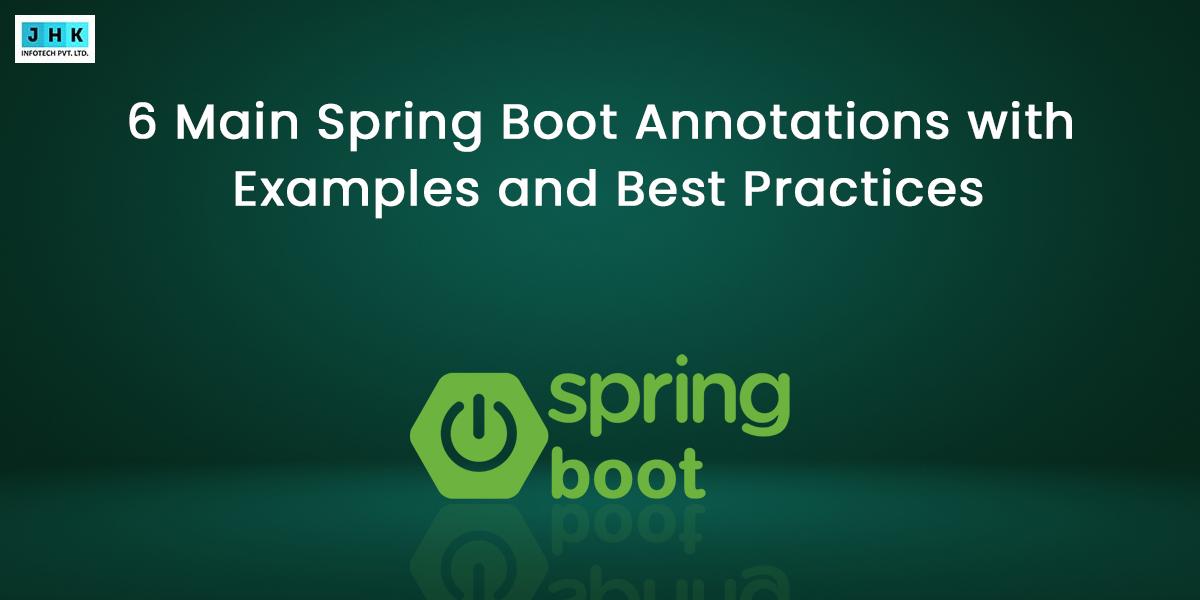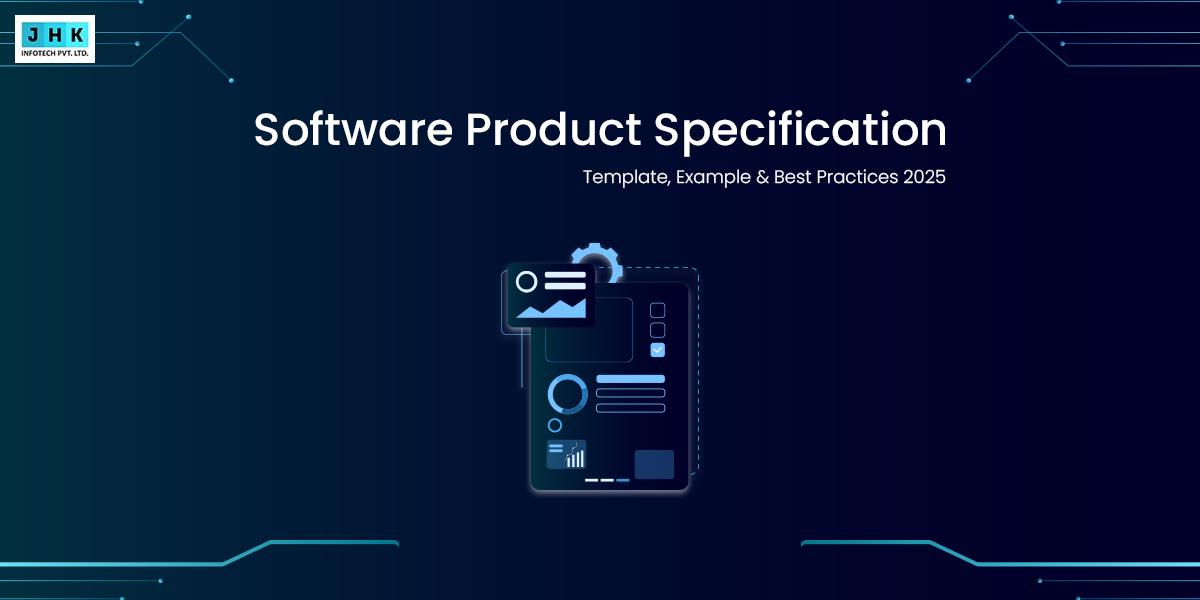6 Main Spring Boot Annotations with Examples and Best Practices

Spring Boot accelerates application development by relying on convention over configuration to reduce manual setup. One of the key tools that power this simplicity is annotations. In this comprehensive guide, we’ll walk you through the most important Spring Boot annotations, grouped by purpose, and backed with examples and use cases.
What Are Spring Boot Annotations?
Spring Boot annotations are metadata tags used to simplify configuration and automate behavior in your application. They eliminate the need for extensive XML configurations and allow developers to build clean, maintainable codebases. These annotations are built on top of Java annotations and are a central feature in Spring’s declarative programming model.
Benefits:
- Reduce boilerplate code
- Improve readability and structure
- Enable faster development and deployment
List of Common Spring Boot Annotations (Grouped by Purpose)
Core Annotations
- @SpringBootApplication: This annotation serves as the foundation for every Spring Boot application. It bundles three critical annotations—@Configuration, @EnableAutoConfiguration, and @ComponentScan—allowing you to bootstrap your application with a single line.
- @Configuration: Denotes that a class declares one or more @Bean methods and can be processed by the Spring container to generate bean definitions and service requests.
- @ComponentScan: Instructs Spring to scan specific packages for annotated components (@Component, @Service, @Repository) to register them as beans in the application context.
- @EnableAutoConfiguration: Automatically configures your Spring Boot application based on the dependencies available in the classpath. It saves you from defining beans manually in many cases.
Dependency Injection Annotations
- @Component: A generic stereotype for any Spring-managed component. It is the base annotation that enables Spring to detect custom beans during classpath scanning.
- @Service: Indicates that a class performs a service task, such as business logic or data transformation. It helps with semantic clarity and is functionally similar to @Component.
- @Repository: Indicates that a class functions as a Data Access Object (DAO), responsible for handling database operations and interactions. Spring also enables exception translation for such classes.
- @Autowired: Automatically wires dependencies by type from the Spring container. It can be applied to constructors, fields, or setters.
- @Qualifier: Used in combination with @Autowired to specify which bean to inject when multiple candidates of the same type are available.
- @Primary: Marks a bean as the preferred candidate when multiple options are present for dependency injection.
Prefer constructor-based injection for improved testability, immutability, and better support for final fields.
Web & REST API Annotations
- @RestController: A shortcut annotation that merges @Controller and @ResponseBody, enabling you to build RESTful web services that return data directly as responses. It signals that the annotated class handles REST requests and returns data (typically JSON) rather than views.
- @RequestMapping: Maps HTTP requests to specific handler methods based on criteria such as URL paths, HTTP methods, request parameters, and headers.
- @GetMapping, @PostMapping, @PutMapping, @DeleteMapping: Shortcuts for @RequestMapping with specific HTTP methods, making code more readable and concise.
- @PathVariable: Maps a URI path variable to a method parameter, allowing dynamic extraction of values from the URL.
- @RequestParam: Binds a query parameter in the request URL to a method parameter.
- @RequestBody: Deserializes the request body into a Java object, often used in POST/PUT methods.
Configuration & Bean Management
- @Value: Injects values from external configuration sources, such as application.properties, application.yml, or environment variables, directly into fields or method parameters.
- @PropertySource: Loads external property files into the Spring environment, allowing you to reference them using @Value or Environment.
- @Bean: Used within @Configuration classes to declare individual bean instances manually.
Lifecycle and AOP Annotations
- @PostConstruct: Executes after all dependencies have been injected, making it ideal for running initialization logic before the bean becomes active.
- @PreDestroy: Called just before the bean is destroyed, typically used for cleanup.
- @Transactional: Manages database transactions. Can be used at the class or method level to manage transactions and automatically roll back in case of exceptions.
- @Aspect: Marks a class as an aspect, part of the Spring AOP framework. Used to isolate cross-cutting concerns such as logging, security, or performance monitoring from core business logic.
- @Before, @After, @Around: Specify the execution points (join points) where aspect-oriented advice should be applied during method execution.
Looking to build a scalable app with Spring Boot? Explore our custom web and app development services.
Testing Annotations
- @SpringBootTest: Launches the entire Spring Boot application context during testing, making it ideal for integration tests.
- @MockBean: Generates a Mockito mock of a Spring bean, allowing you to substitute real components in the application context for unit or integration testing purposes.
- @TestConfiguration: Lets you define custom bean configurations that are loaded only during test execution, providing test-specific context. Used for test-specific configurations.
- @WebMvcTest: Loads only the web layer (controllers, filters, etc.) into the application context for faster, more focused testing.
Spring Boot Annotations with Examples
Example: Creating a Simple REST Controller
@RestController
@RequestMapping("/api")
public class UserController {
@GetMapping("/hello")
public String sayHello() {
return "Hello, Spring Boot!";
}
}
Example: Using @Autowired and @Service
@Service
public class UserService {
public String getUser() {
return "John Doe";
}
}
@RestController
public class UserController {
private final UserService userService;
@Autowired
public UserController(UserService userService) {
this.userService = userService;
}
@GetMapping("/user")
public String fetchUser() {
return userService.getUser();
}
}
Spring Boot Annotation Best Practices
- Use @Component, @Service, and @Repository wisely: Apply these annotations according to your class’s responsibility. Use @Component for general-purpose beans, @Service for business logic, and @Repository for data access layers. This helps with cleaner code structure and better readability.
- Favor constructor injection over field injection: Constructor injection ensures that dependencies are provided at object creation time, making classes immutable and easier to test. It helps prevent hidden dependencies and encourages fail-fast behavior by catching configuration issues early.
- Resolve ambiguity using @Qualifier: When multiple beans of the same type exist in the context, use @Qualifier to clearly specify which one should be injected. This avoids runtime errors and improves clarity.
- Group related configuration properties: Use @ConfigurationProperties to bind groups of related properties from your application.properties or application.yml files into a single POJO. This leads to cleaner configuration management and type-safe access.
- Avoid annotation overload: Don’t clutter a single class with too many annotations. Doing so makes the class harder to read and maintain. Instead, follow the single responsibility principle and distribute logic across multiple focused classes.
- Document custom annotations: If you create your own annotations for modular or reusable behaviors, be sure to document their use cases and any preconditions clearly.
- Keep business logic out of controllers: Use service classes annotated with @Service to separate business logic from controllers. This ensures better maintainability and unit testing.
- Regularly audit annotations: As your project evolves, revisit annotated components to ensure they’re still necessary and appropriately placed.
FAQ’s
1. What are annotations in Spring Boot?
Annotations in Spring Boot are metadata tags used to provide instructions to the Spring framework. They simplify configuration, reduce boilerplate code, and enable declarative programming by marking classes, methods, fields, or parameters with specific behaviors or roles.
2. What are the different annotations in Spring Boot and their purpose in detail?
Some key Spring Boot annotations and their purposes include:
- @SpringBootApplication: Combines @Configuration, @EnableAutoConfiguration, and @ComponentScan to bootstrap a Spring Boot application.
- @RestController: Marks a class as a RESTful web service controller.
- @RequestMapping: Maps HTTP requests to handler methods.
- @Autowired: Automatically injects dependencies.
- @Component/@Service/@Repository: Marks classes as Spring-managed beans with specific roles.
- @Value: Injects values into fields from properties files or environment variables.
- @Configuration: Marks the class as a source of bean definitions, allowing the Spring IoC container to process and register the beans it defines.
- @Bean: Declares a bean explicitly within a @Configuration class.
- @PathVariable / @RequestParam: Bind method parameters to URL path variables or query parameters.
3. What are the annotations used in Spring Boot?
Commonly used annotations in Spring Boot include:
- @SpringBootApplication
- @RestController
- @GetMapping, @PostMapping, @PutMapping, @DeleteMapping
- @Autowired
- @Component, @Service, @Repository
- @Value
- @Configuration, @EnableAutoConfiguration
- @Entity, @Table, @Id (for JPA)
- @RequestBody, @PathVariable, @RequestParam
4. What is the use of Spring Boot annotations?
Spring Boot annotations are used to:
- Simplify application setup and configuration.
- Define components and manage dependencies automatically.
- Handle HTTP requests and responses in web applications.
- Map application properties to variables.
- Enable declarative programming and reduce XML configurations.
5. What is the annotation used in Spring Boot to make a value compulsory?
To enforce a required value in Spring Boot, you can use:
@Value("${some.property}")
private String value;
If some.property is missing, the app may fail to start.
To explicitly make it required:
@Value("${some.property:}")
@NonNull
Alternatively, you can use JSR-303 validation with:
@Validated
public class Config {
@NotBlank
@Value("${app.name}")
private String appName;
}
6. What is Spring Boot annotation and its benefits?
Spring Boot annotations provide declarative instructions that allow Spring to automatically configure and manage components.
Benefits include:
- Reduced boilerplate code.
- Simplified configuration.
- Improved code readability.
- Better dependency management.
- Faster development with convention over configuration.
7. What annotation is used for an orchestrator in Spring Boot?
There is no specific annotation named “orchestrator,” but commonly used annotations for orchestrating services or workflows include:
- @Service: Used to define a service layer component that orchestrates logic between repositories and controllers.
- @Transactional: Ensures that a series of method calls are handled within a database transaction.
- @Async: Enables asynchronous method execution.
- @Scheduled: Used for scheduled orchestration or timed tasks.
Conclusion
Spring Boot annotations are powerful tools that make development faster, cleaner, and more intuitive. By understanding and using the right annotations, you can write efficient, maintainable, and scalable Spring Boot applications.
Keep this list bookmarked as your quick-reference guide for Spring Boot annotations. And if you’re just getting started with Spring Boot, check out our beginner’s guide to build your first application in minutes!










